The Urban Gradient in Malaria-Endemic Municipalities in Acre: Revisiting the Role of Locality
Abstract
1. Introduction
2. Materials and Methods
2.1. Study Area
2.2. Data
2.3. Urbanization Model
- A local reference: intensity levels are defined in relation to a local reference that establishes what is the most urban setting in the analyzed context. Intensities vary from the highest urban grade at the local reference to the lowest urban grade at the places less similar to the local urban grade reference. For this study, the town of Mâncio Lima (ML) was adopted as the local urban reference because it has the largest number of inhabitants and is considered a place of greater economic and administrative importance by the population, when compared to RA, which was also inventoried.
- Spatial unit of analysis and data integration: each of the 40 localities inventoried by Lana et al. [19] corresponds to the spatial observation units.
- Set of variables: a minimum set of variables is required so that urbanization intensity indicators can represent the complexities of the Amazonian urbanization process. This set of variables is used as proxies of each dimension analyzed, and they were selected based on Dal’Asta et al. [25] criteria. The lack of longitudinal household survey data precluded the analysis of the evolution of urbanization, as originally proposed for the action dimension.
2.3.1. Characterization of the Spatial Forms: System of Objects
2.3.2. Characterization of the Social Content: System of Values
3. Results
4. Discussion
5. Conclusions
Author Contributions
Acknowledgments
Conflicts of Interest
References
- Arnaiz-Schmitz, C.; Schmitz, M.F.; Herrero-Jauregui, C.; Gutierrez-Angonese, J.; Pineda, F.D.; Montes, C. Identifying socio-ecological networks in rural-urban gradients: Diagnosis of a changing cultural landscape. Sci. Total Environ. 2018, 612, 625–635. [Google Scholar] [CrossRef] [PubMed]
- Limonad, E.; Monte-Mór, R. Beyond the right to the city: Between the rural and the urban. Rev. Electrón. Geogr. Cienc. Soc. 2015, 13, 103–115. [Google Scholar]
- Nagendra, H.; Unnikrishnan, H.; Sen, S. Villages in the city: Spatial and temporal heterogeneity in rurality and urbanity in Bangalore, India. Land 2014, 3, 1–18. [Google Scholar] [CrossRef]
- Taccoli, C. The links between urban and rural development. Environ. Urban. 2003, 15, 3–12. [Google Scholar] [CrossRef]
- Lourenço, A.E.P. The meaning of ‘rural’ in rural health: A review and case study from Brazil. Glob. Public Health 2012, 7, 1–13. [Google Scholar] [CrossRef] [PubMed]
- O’Reilly, G.; O’Reilly, D.; Rosato, M.; Connolly, S. Urban and rural variations in morbidity and mortality in Northern Ireland. BMC Public Health 2007, 7, 123. [Google Scholar] [CrossRef] [PubMed]
- Hart, L.G.; Larson, E.H.; Lishner, D.M. Rural definitions for health policy and research. Am. J. Public Health 2005, 95, 1149–1155. [Google Scholar] [CrossRef] [PubMed]
- Cyril, S.; Oldroyd, J.C.; Renzaho, A. Urbanisation, urbanicity, and health: A systematic review of the reliability and validity of urbanicity scales. BMC Public Health 2013, 13, 513. [Google Scholar] [CrossRef] [PubMed]
- Jones, A.D.; Acharya, Y.; Galway, L.P. Urbanicity gradients are associated with the household- and individual-level double burden of malnutrition in sub-Saharan Africa. J. Nutr. 2016, 146, 1257–1267. [Google Scholar] [CrossRef] [PubMed]
- Wilson, M.L.; Krogstad, D.J.; Arinaitwe, E.; Arevalo-Herrera, M.; Chery, L.; Ferreira, M.U.; Ndiaye, D.; Mathanga, D.P.; Eapen, A. Urban malaria: Understanding its epidemiology, ecology, and transmission across seven diverse icemr network sites. Am. J. Trop. Med. Hyg. 2015, 93, 110–123. [Google Scholar] [CrossRef] [PubMed]
- Hay, S.I.; Guerra, C.A.; Tatem, A.J.; Atkinson, P.M.; Snow, R.W. Urbanization, malaria transmission and disease burden in Africa. Nat. Rev. Microbiol. 2005, 3, 81–90. [Google Scholar] [CrossRef] [PubMed]
- Hall, S.A.; Kaufman, J.S.; Ricketts, T.C. Defining urban and rural areas in U.S. Epidemiologic studies. J. Urban Health 2006, 83, 162–175. [Google Scholar] [CrossRef] [PubMed]
- Siri, J.G.; Lindblade, K.A.; Rosen, D.H.; Onyango, B.; Vulule, J.; Slutsker, L.; Wilson, M.L. Quantitative urban classification for malaria epidemiology in sub-Saharan Africa. Malar. J. 2008, 7, 34. [Google Scholar] [CrossRef] [PubMed]
- Cohen, S.A.; Cook, S.K.; Kelley, L.; Foutz, J.D.; Sando, T.A. A closer look at rural-urban health disparities: Associations between obesity and rurality vary by geospatial and sociodemographic factors. J. Rural Health 2017, 33, 167–179. [Google Scholar] [CrossRef] [PubMed]
- Helbich, M.; Blüml, V.; de Jong, T.; Plener, P.L.; Kwan, M.-P.; Kapusta, N.D. Urban–rural inequalities in suicide mortality: A comparison of urbanicity indicators. Int. J. Health Geogr. 2017, 16, 39. [Google Scholar] [CrossRef] [PubMed]
- Sacks, J.D.; Rappold, A.G.; Davis, J.A., Jr.; Richardson, D.B.; Waller, A.E.; Luben, T.J. Influence of urbanicity and county characteristics on the association between ozone and asthma emergency department visits in North Carolina. Environ. Health Perspect. 2014, 122, 506–512. [Google Scholar] [CrossRef] [PubMed]
- Novak, N.L.; Allender, S.; Scarborough, P.; West, D. The development and validation of an urbanicity scale in a multi-country study. BMC Public Health 2012, 12, 530. [Google Scholar] [CrossRef] [PubMed]
- Tatem, A.J.; Gething, P.W.; Smith, D.L.; Hay, S.I. Urbanization and the global malaria recession. Malar. J. 2013, 12, 133. [Google Scholar] [CrossRef] [PubMed]
- Lana, R.M.; Riback, T.I.S.; Lima, T.F.M.; da Silva-Nunes, M.; Cruz, O.G.; Oliveira, F.G.S.; Moresco, G.G.; Honório, N.A.; Codeço, C.T. Socioeconomic and demographic characterization of an endemic malaria region in Brazil by multiple correspondence analysis. Malar. J. 2017, 16, 397. [Google Scholar] [CrossRef] [PubMed]
- Da Silva-Nunes, M.; Moreno, M.; Conn, J.E.; Gamboa, D.; Abeles, S.; Vinetz, J.M.; Ferreira, M.U. Amazonian malaria: Asymptomatic human reservoirs, diagnostic challenges, environmentally driven changes in mosquito vector populations, and the mandate for sustainable control strategies. Acta Trop. 2012, 121, 281–291. [Google Scholar] [CrossRef] [PubMed]
- Angelo, J.R.; Katsuragawa, T.H.; Sabroza, P.C.; de Carvalho, L.A.S.; de Silva, L.H.P.; Nobre, C.A. The role of spatial mobility in malaria transmission in the Brazilian Amazon: The case of Porto Velho municipality, Rondônia, Brazil (2010–2012). PLoS ONE 2017, 12, e0172330. [Google Scholar] [CrossRef] [PubMed]
- Ferreira, M.U.; Castro, M.C. Challenges for malaria elimination in Brazil. Malar. J. 2016, 15, 284. [Google Scholar] [CrossRef] [PubMed]
- PAHO. Report on the Situation of Malaria in the Americas 2014; Pan American Health Organization: Washington, DC, USA, 2016; p. 114. [Google Scholar]
- De Reis, I.C.; Honório, N.A.; de Barros, F.S.M.; Barcellos, C.; Kitron, U.; Camara, D.C.P.; Pereira, G.R.; Keppeler, E.C.; da Silva-Nunes, M.; Codeço, C.T. Epidemic and endemic malaria transmission related to fish farming ponds in the Amazon frontier. PLoS ONE 2015, 10, e0137521. [Google Scholar]
- Dal’Asta, A.P.; Amaral, S.; Monteiro, A.M.V. Um modelo para a representação espaço-temporal do fenômeno urbano na Amazônia Contemporânea. Rev. Políticas Públicas Cid. 2017, 5, 20. [Google Scholar]
- Monte-Mór, R.L.M. O que é o Urbano, no Mundo Contemporâneo; Texto Para Discussão 281; UFMG/Cedeplar: Belo Horizonte, Brazil, 2006; p. 14. [Google Scholar]
- Becker, B.K. Uma hipótese sobre a origem do fenômeno urbano numa fronteira de recursos no Brasil. Rev. Bras. Geogr. 1978, 40, 160–184. [Google Scholar]
- Becker, B.K. A Amazônia na estrutura espacial do Brasil. Rev. Bras. Geogr. 1974, 36, 3–33. [Google Scholar]
- Becker, B.K. Undoing myths: The Amazon—An urbanized forest. In Brazilian Perspectives on Sustainable Development of the Amazon Region—Man and Biosphere Series; Clüsener, M.G., Sachs, I., Eds.; UNESCO and Parthenon Publish Group Limited: Paris, France, 1995; pp. 53–89. [Google Scholar]
- IBGE. Censo Demográfico 2010; IBGE, Ed.; IBGE: Rio de Janeiro, Brazil, 2010.
- IBGE; SUFRAMA. Produto Interno Bruto dos Municípios. Available online: https://cidades.ibge.gov.br/brasil/ac/rodrigues-alves/pesquisa/38/46996?ano=2014 (accessed on 14 February 2018).
- Ministério da Saúde (MS). Situação Epidemiológica—Dados; Ministério da Saúde: Brasília, Brazil, 2014.
- Secretaria de Vigilância em Saúde (SVS)/MS. Boletim Epidemiológico; MS: Brasília, Brazil, 2017.
- Instituto Nacional de Pesquisas Espaciais (INPE); Embrapa. Terraclass; INPE: São José dos Campos, Brazil, 2014. [Google Scholar]
- De Almeida, C.A.; Coutinho, A.C.; Esquerdo, J.C.D.M.; Adami, M.; Venturieri, A.; Diniz, C.G.; Dessay, N.; Durieux, L.; Gomes, A.R. High spatial resolution land use and land cover mapping of the Brazilian legal Amazon in 2008 using landsat-5/tm and modis data. Acta Amaz. 2016, 46, 291–302. [Google Scholar] [CrossRef]
- Dal’Asta, A.P. Representações do Fenômeno Urbano na Amazônia Contemporânea: Observações no Sudoeste Paraense. Ph.D. Thesis, Instituto Nacional de Pesquisas Espaciais (INPE), São José dos Campos, Brazil, 2016. [Google Scholar]
- Saaty, T.L. The Analytic Hierarchy Process; McGraw-Hill: New York, NY, USA, 1980. [Google Scholar]
- Castells, M. La Cuéstion Urbana, 7th ed.; Siglo Veintiuno: Mexico City, Mexico, 1974. [Google Scholar]
- Cardoso, A.C.D.; Lima, J.J.F. Tipologias e padrões de ocupação urbana na Amazônia oriental: Para que e para quem? In O rural e o Urbano na Amazônia. Diferentes Olhares e Perspectivas; Cardoso, A.C.D., Ed.; EDUFPA: Belém, Brazil, 2006; pp. 55–98. [Google Scholar]
- Hsu, A.; Johnson, L.; Lloyd, A. Measuring Progress: A Practical Guide from the Developers of the Environmental Performance Index (EPI); Yale Center for Environmental Law & Policy: New Haven, CT, USA, 2013. [Google Scholar]
- Amaral, S.; Dal’Asta, A.P.; Brigatti, N.; de Pinho, C.M.D.; de Castro Medeiros, L.C.; de Andrade, P.R.; Pinheiro, T.F.; Alves, P.A.; Escada, M.I.S.; Monteiro, A.M.V. Comunidades ribeirinhas como forma socioespacial de expressão urbana na Amazônia: Uma tipologia para a região do Baixo Tapajós (Pará-Brasil). Rev. Bras. Estud. Popul. 2013, 30, 367–399. [Google Scholar] [CrossRef]
- MS. Plano de Eliminação de Malária no Brasil; Ministério da Saúde: Brasília, Brazil, 2016; p. 41.
- Barbieri, A.F.; Monte-Mór, R.L.M.; Bilsborrow, R.E. Towns in the jungle: Exploring linkages between rural-urban mobility, urbanization and development in the Amazon. In Urban Population-Environment Dynamics in the Developing World: Case Studies and Lessons Learned; Sherbiniin, A., Rahman, A., Barbieri, A.F., Fotso, J.C., Zhu, Y., Eds.; Committee for International Cooperation in National Research in Demography (CICRED): Paris, France, 2009; pp. 247–279. [Google Scholar]
- Becker, B.K. A Urbe Amazônida: Entre a Floresta e a Cidade; Garamond: Rio de Janeiro, Brazil, 2013. [Google Scholar]
- UN-HABITAT. International Guidelines on Urban and Territorial Planning; United Nations Human Settlements Programme (UN-Habitat): Nairobi, Kenya, 2015. [Google Scholar]
- IBGE. Classificação e Caracterização dos Espaços Rurais e Urbanos do Brasil: Uma Primeira Aproximação; IBGE: Rio de Janeiro, Brazil, 2017; p. 84.
- Monte-Mór, R.L.M. Modernities in the Jungle: Extended Urbanization in the Brazilian Amazon. Ph.D. Thesis, University of California, Los Angeles, CA, USA, 2004. [Google Scholar]
- Parry, L.; Day, B.; Amaral, S.; Peres, C.A. Drivers of rural exodus from Amazonian headwaters. Popul. Environ. 2010, 32, 137–176. [Google Scholar] [CrossRef]
- Guedes, G.; Costa, S.; Brondízio, E. Revisiting the hierarchy of urban areas in the Brazilian Amazon: A multilevel approach. Popul. Environ. 2009, 30, 159–192. [Google Scholar] [CrossRef] [PubMed]
- Moonen, B.; Cohen, J.M.; Snow, R.W.; Slutsker, L.; Drakeley, C.; Smith, D.L.; Abeyasinghe, R.R.; Rodriguez, M.H.; Maharaj, R.; Tanner, M.; et al. Operational strategies to achieve and maintain malaria elimination. Lancet 2010, 376, 1592–1603. [Google Scholar] [CrossRef]
- Macauley, C. Aggressive active case detection: A malaria control strategy based on the Brazilian model. Soc. Sci. Med. 2005, 60, 563–573. [Google Scholar] [CrossRef] [PubMed]
- Da Silva, N.S.; da Silva-Nunes, M.; Malafronte, R.S.; Menezes, M.J.; D’Arcadia, R.R.; Komatsu, N.T.; Scopel, K.K.; Braga, E.M.; Cavasini, C.E.; Cordeiro, J.A.; et al. Epidemiology and control of frontier malaria in Brazil: Lessons from community-based studies in rural Amazonia. Trans. R. Soc. Trop. Med. Hyg. 2010, 104, 343–350. [Google Scholar] [CrossRef] [PubMed]
- NIC. Pesquisa Sobre zo Uso das Tecnologias de Informação e Comunicação nos Domicílios Brasileiros: Tic Domicílios 2016; Núcleo de Informação e Coordenação do Ponto BR, Ed.; Comitê Gestor da Internet no Brasil: São Paulo, Brazil, 2017; p. 430.
- Silva, J.G. O novo no rural brasileiro. Nova Econ. 1997, 7, 43–81. [Google Scholar]
- Tauil, P.; Daniel-Ribeiro, C. Some aspects of epidemiology and control of Malaria in Brazil. Res. Rev. Parasitol. 1998, 58, 163–167. [Google Scholar]
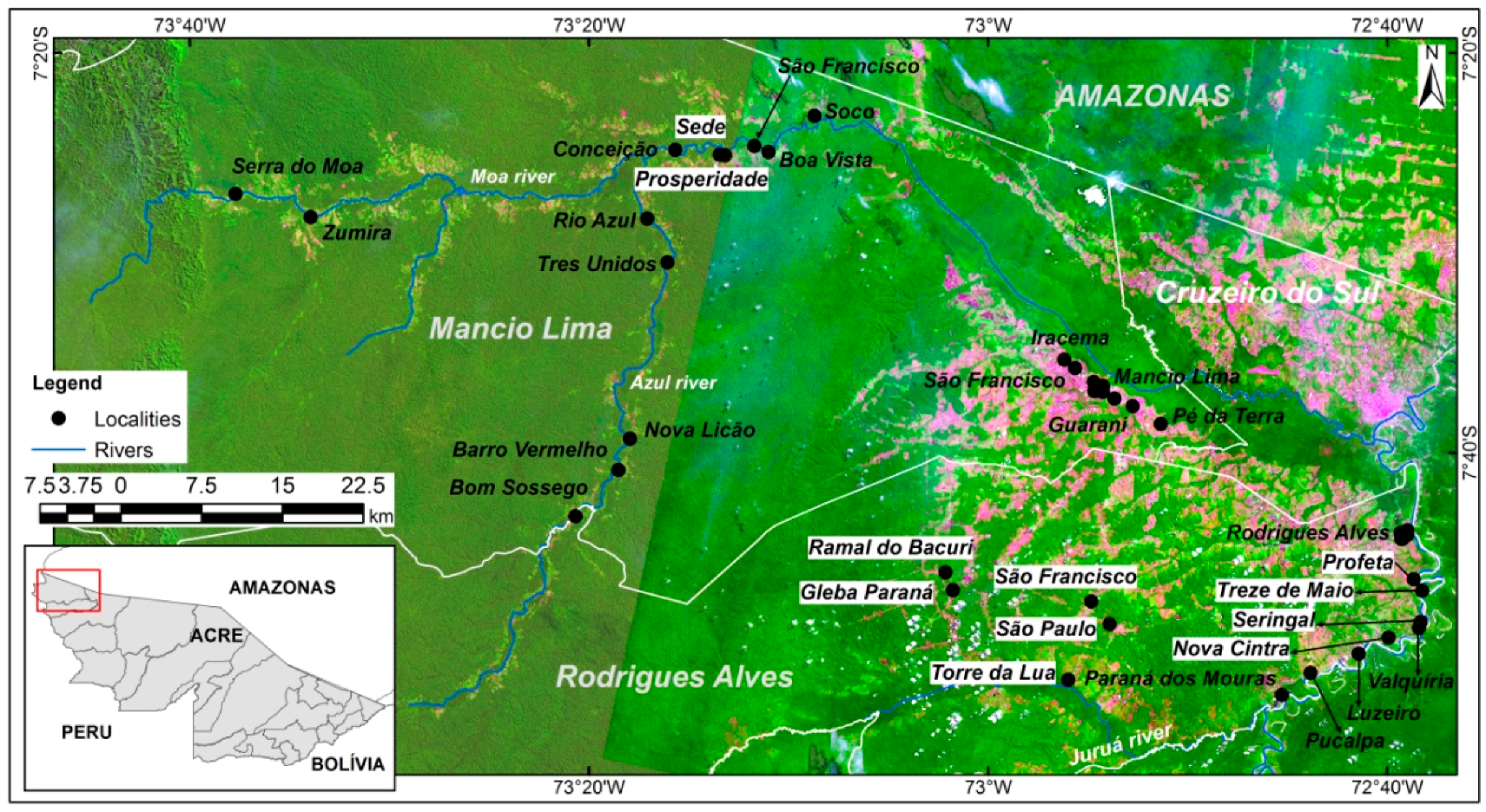


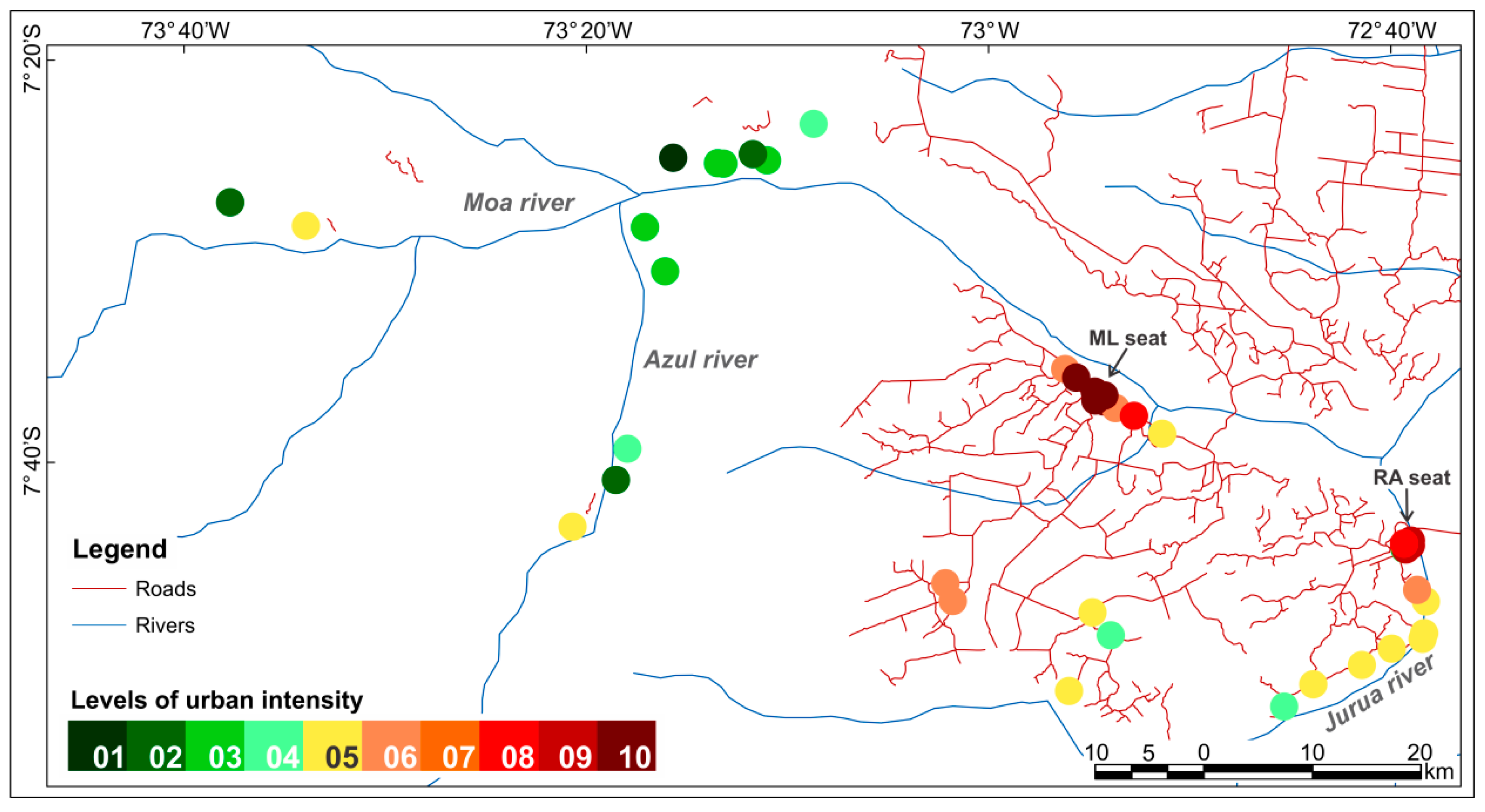
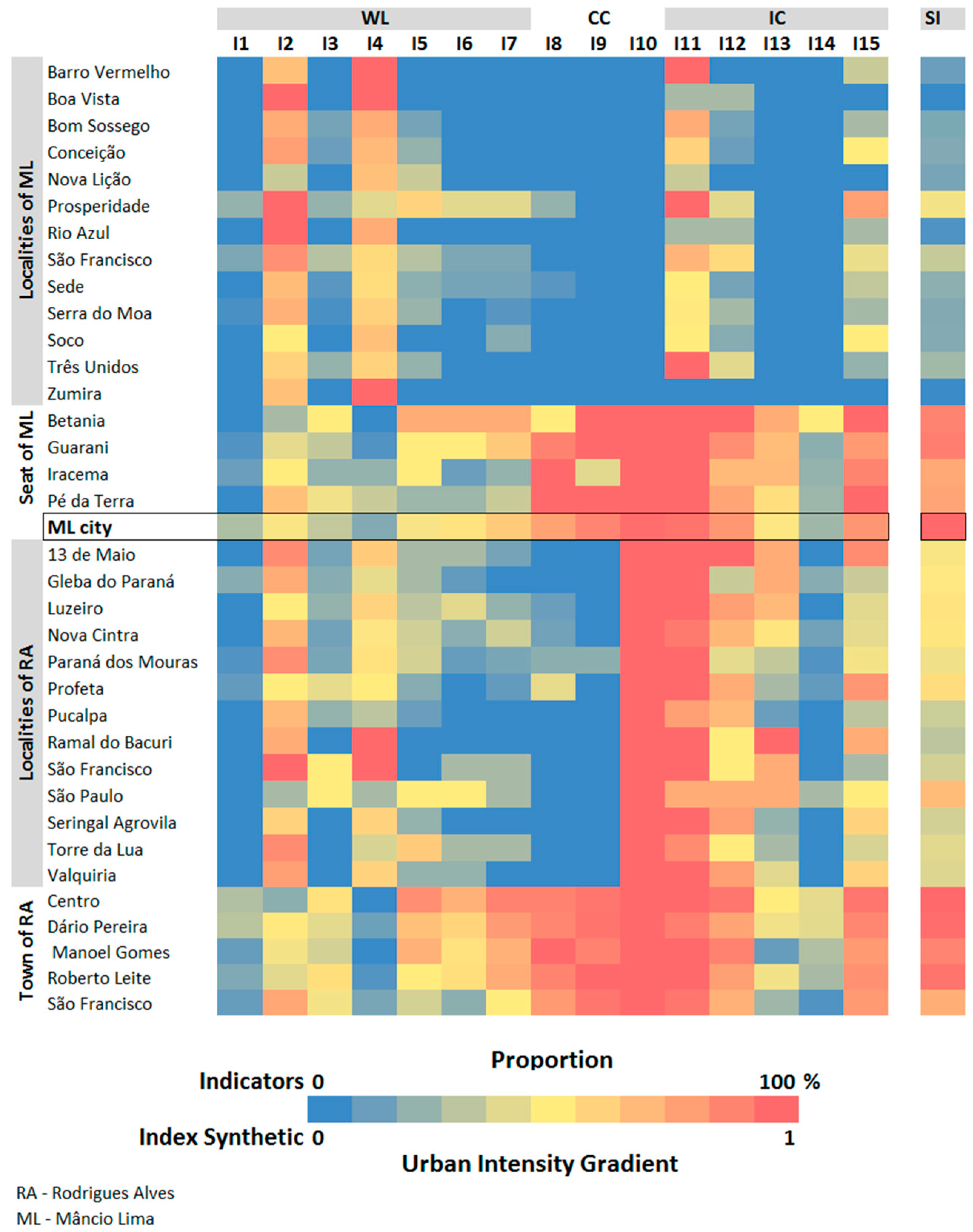

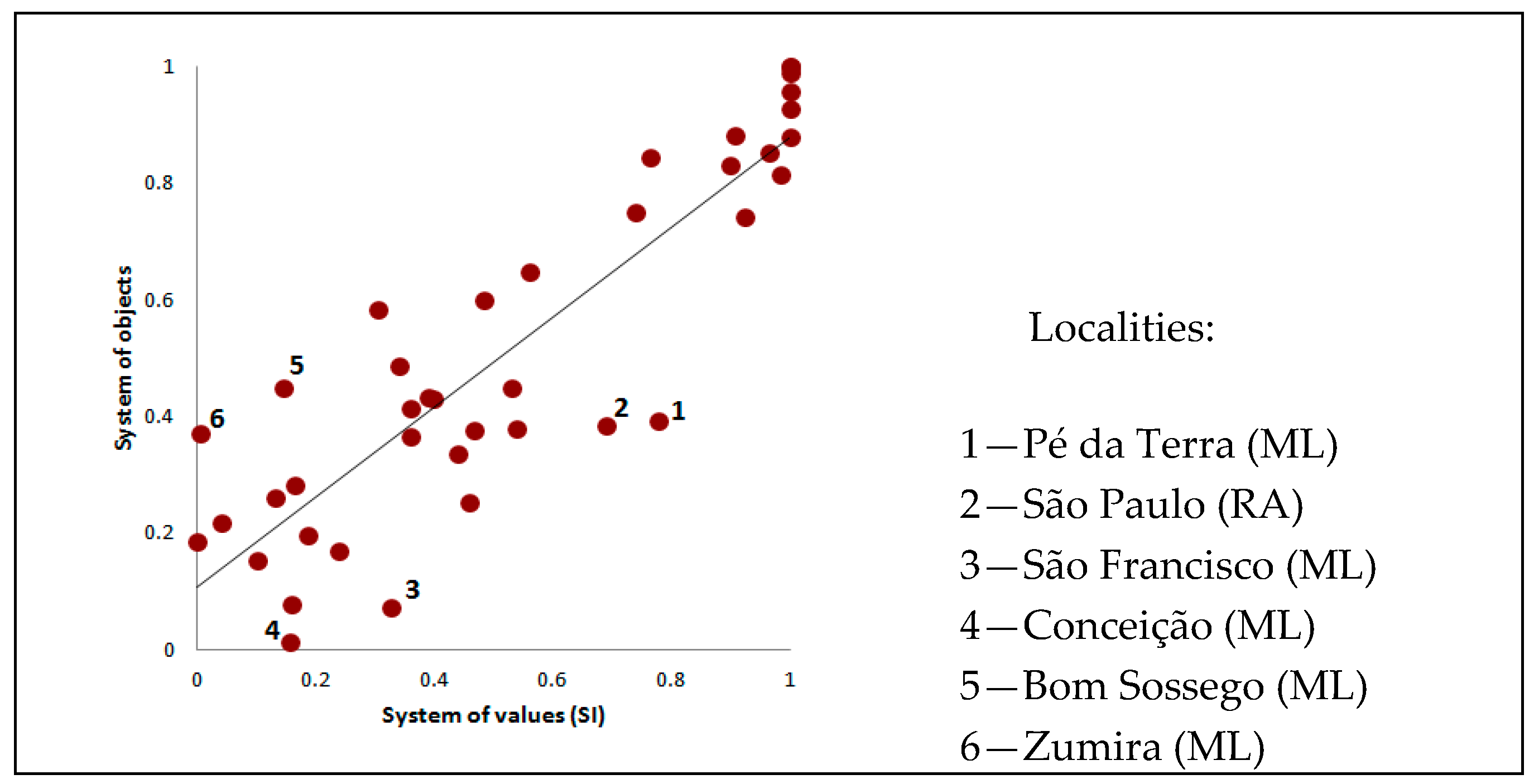
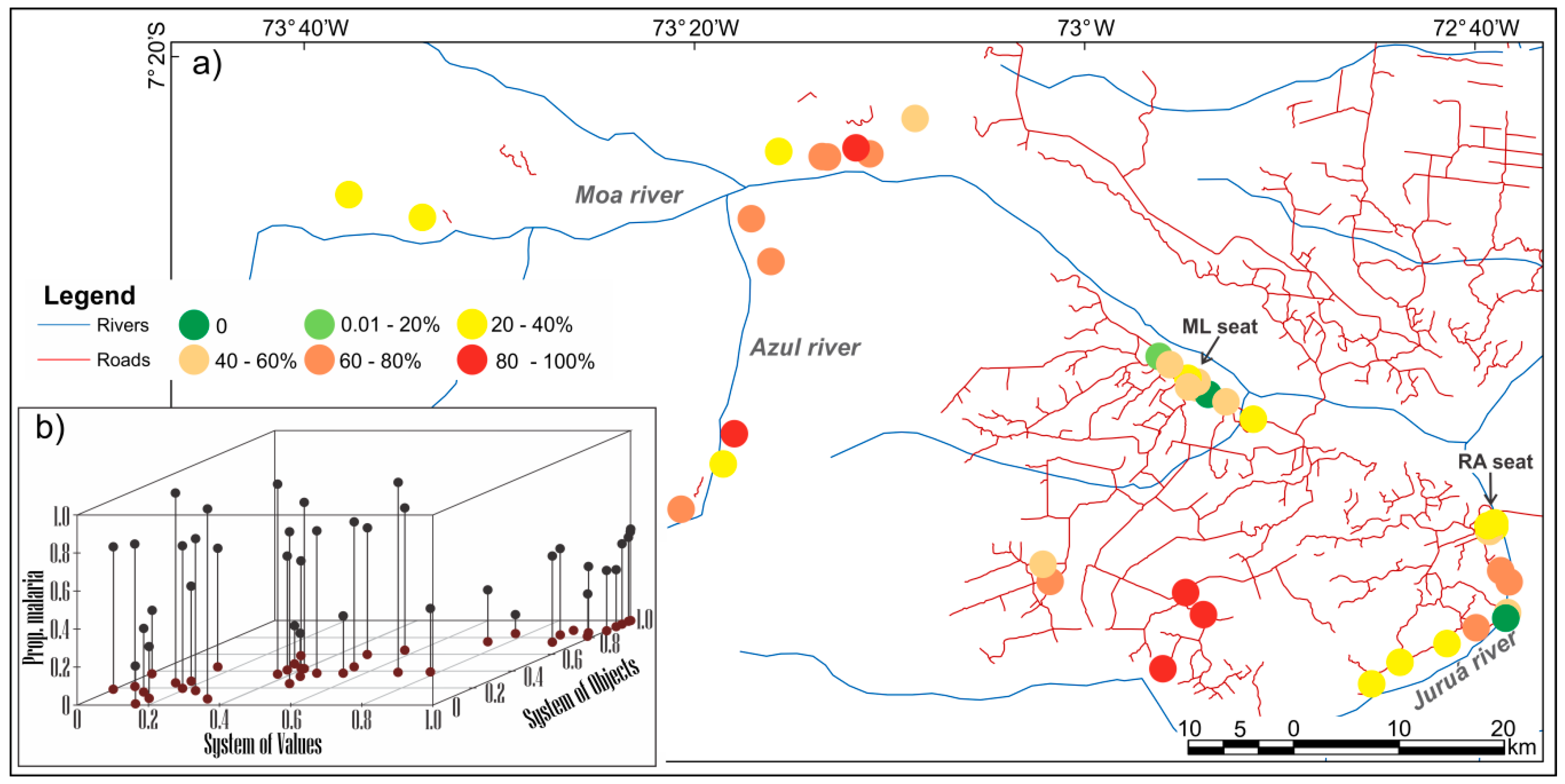
| Group 1 | Information | Variables |
|---|---|---|
| Household goods | Ownership of goods | TV; blender; motorcycle; computer; Facebook account; internet on smartphone or computer. |
| Occupation and income | Income by householders’ occupation type | Income derived from: agriculture, cattle, fishing, subsistence agriculture surplus, forest products, crafts and domestic labor. Income derived from: public service, cleaner, work with a formal contract, driver or boatman, social benefits (income transfer programs), general services (school positions, bus ticket collector). |
| Water supply | Water access Bathroom facilities | Piped water within the residence or only in the yard. Shower facility indoors and enclosed place for needs. |
| Garbage disposal | Waste destination | Household garbage collected by the public service. |
| Access to electricity | Electricity inside household | Electric power supplied by conventional network. |
| Group | Indicators | Justification |
|---|---|---|
| WL | I1—Proportion of households with a Facebook account | These indicators refer to new arrangements in the countryside regarding the occupational profiles of its population and the introduction of elements of rationality and modernity disseminated by the cities. This mediation seeks to understand the contemporary transformation of the official rural settlements considering a context of extensive urbanization [26]. The indicators associated with the type of bathrooms (I6 and I7) refer to the traditional behavior of the Amazonian people and the insertion of new habits. The presence of social benefits, in some cases associated with traditional activities, indicate trade monetization and insertion of the population into a market economy. |
| I2—Proportion of households receiving social benefits (Bolsa Família, Bolsa Verde e Bolsa Pesca) 1 | ||
| I3—Proportion of households with internet access | ||
| I4—Proportion of households in which income is exclusively from “rural” activities | ||
| I5—Proportion of households in which at least one source of income is from “urban” activities | ||
| I6—Proportion of households with shower indoors | ||
| I7—Proportion of households with an enclosed place for needs (septic tank or toilet) | ||
| CC | I8—Proportion of households served by water supply system | These indicators refer to the numerous goods and services (of universal value) that tend to be produced and consumed at a collective level in the cities [38]. The expectation of access to these services offered preferentially in the cities, reveals the city influence is extrapolating its physical dimension [39]. |
| I9—Proportion of households with regular garbage collection service | ||
| I10—Proportion of households linked to power grid electricity network | ||
| IC | I11—Proportion of households with TV | These indicators refer to the social process of appropriation of consumer goods by individuals. In the context of this work, they are equipment whose access is facilitated and diffused in cities. |
| I12—Proportion of households with blender | ||
| I13—Proportion of households with motorcycle | ||
| I14—Proportion of households with computer | ||
| I15—Proportion of households with cellular phone |
© 2018 by the authors. Licensee MDPI, Basel, Switzerland. This article is an open access article distributed under the terms and conditions of the Creative Commons Attribution (CC BY) license (http://creativecommons.org/licenses/by/4.0/).
Share and Cite
Dal’Asta, A.P.; Lana, R.M.; Amaral, S.; Codeço, C.T.; Monteiro, A.M.V. The Urban Gradient in Malaria-Endemic Municipalities in Acre: Revisiting the Role of Locality. Int. J. Environ. Res. Public Health 2018, 15, 1254. https://doi.org/10.3390/ijerph15061254
Dal’Asta AP, Lana RM, Amaral S, Codeço CT, Monteiro AMV. The Urban Gradient in Malaria-Endemic Municipalities in Acre: Revisiting the Role of Locality. International Journal of Environmental Research and Public Health. 2018; 15(6):1254. https://doi.org/10.3390/ijerph15061254
Chicago/Turabian StyleDal’Asta, Ana Paula, Raquel Martins Lana, Silvana Amaral, Cláudia Torres Codeço, and Antônio Miguel Vieira Monteiro. 2018. "The Urban Gradient in Malaria-Endemic Municipalities in Acre: Revisiting the Role of Locality" International Journal of Environmental Research and Public Health 15, no. 6: 1254. https://doi.org/10.3390/ijerph15061254
APA StyleDal’Asta, A. P., Lana, R. M., Amaral, S., Codeço, C. T., & Monteiro, A. M. V. (2018). The Urban Gradient in Malaria-Endemic Municipalities in Acre: Revisiting the Role of Locality. International Journal of Environmental Research and Public Health, 15(6), 1254. https://doi.org/10.3390/ijerph15061254





